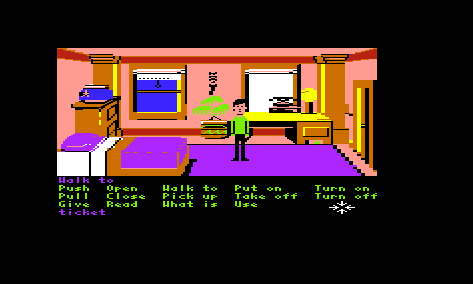beamrider wrote:Excuse my ignorance but do images such as this *have* to be hand pixeled or would it be possible to write some code to convert from higher fidelity source images programmatically and generate the necessary raster splits?
An advice to you: just try it out and
write that converter.

...
My credentials include the implementations of converters for several of the newly constructed graphic modes by tokra and me:
- for MFLI (208x256, 8x8 foreground attributes, background/border/aux. colour on every raster line, strictly multi-colour)
- for VFLI (208x256, 8x1(!) foreground attributes, background/border/aux. colour on every raster line, mixed hires/multi-colour)
- for MINIGRAFIK (160x192, 8x16 foreground, global background/border/aux. colour, mixed hires/multi-colour)
... which all take a full-colour image (24 bit colour) in the correct size as input (resizing can be done on the PC side). Implementations of VFLI also refer to the software-only implementations of Wide-FLI (104x256) and the original FLI mode (72x256).
On the C128, I did comparable converters for tokra's new VDC modes.
What needs to be taken into account is a usable palette, colour spaces (RGB <-> YUV, et alii), colour distance functions, linear vs. gamma-corrected channel intensities, error distribution of any kind (dithering, etc.), applying hardware restrictions in the right way during dithering, and knowing what leads to big combinatorial problems (when attributes are 'coupled') which ultimately decide if such a converter is feasible or not.
In short: you're grossly underestimating the problems one faces when he goes to write such a converter.
I have discussed this kind of problems with tokra quite often when he came up with a new mode. For several modes (or uses of those modes) I needed to decline his requests because a converter would have to put up with BIG combinatorial expenses - it's no use if a converter runs for weeks, months or years on a current PC to find an 'optimal' distribution of attributes before dithering the picture to that attribute setting.
Attributes in that sense include the determination of foreground colour and multi-colour enable for each attribute cell, or either the global setting of background/border/aux. colour, their determination for each raster line, or any conceivable distribution of splits on a single raster line.
With FCB, the 8x4 foreground attribute introduces an unpleasant coupling across 4 rasterlines, for every split that goes across that attribute cell. In principle, for every foreground cell, you have to optimize for at least 4 settings of combinations of brd/bck/aux - if you're unlucky, there could be a split to another four register settings (aux. or brd/bck) each of which multiplies the search space by the factor 16 (aux.) or 128 (brd/bck). So, for each attribute cell, you have to optimize for at least this number of cases: 16 (foreground) x 2048 (globals) x 2048 (globals) x 2048 (globals) x 2048 (globals) combinations = 281474976710656 combinations; in the worst case, 16 x 2048^4 x 128^4 combinations = 75557863725914323419136 combinations - and that has to be done for all 1008 attribute cells. Not all those combinations are actually realisable (splits must be at least 16 pixels wide but could be done every 24 pixels), so this number decreases a bit.
With MFLI (8x8 attribute cells), I faced a similar problem and could only about handle it by applying a heuristic to the foreground colour attribute cells and restricting the picture to strictly multi-colour. That decoupled the 8 raster lines and I could then optimize the 'globals' for a complete raster line each, i.e. 2048 combinations only for each raster.
I did actually apply the same method to FCB, with a foreground heuristic to its 8x4 cells, but of course this converter does not handle hires attributes (again, only strictly multi-colour), and it does not produce any splits at all; i.e. it misses out on any of FCB advanced features.
The MG converter does 2048 tries for all combinations of global colours (really, global to the whole screen), then - for each of the 2048 settings! - does a first pass with simple 1D dithering to work out all foreground colours (hires or multicolour), and then a second pass where it dithers 2D with the best one of the 2048 settings it found to produce the result. As the restrictions of that mode are so severe, it often cannot find any good combination of background/border/aux. colour at all and then the result is a wild colour soup where the dither algorithm helplessly meanders around to find good approximations to the colours in the image.
The converter for VFLI maybe was the 'simplest' of the lot to write. Here, the problems decouples into 256 'screens' where their globals can be optimized independently, and the foreground attribute cells also can be optimized on their own. There is a minimal coupling from one attribute cell to the next and from one raster to the next, but that is easily handled by the error distribution. Even though, it incured a full 2 days headache when I had finished the first working prototype. The MG converter was derived mostly from the VFLI converter, without that preparation I couldn't have implemented the MG converter at all.
...
So much for even more boring tech-talk, but now you know why I refrained from starting out writing a converter for the FCB mode in the first place.
